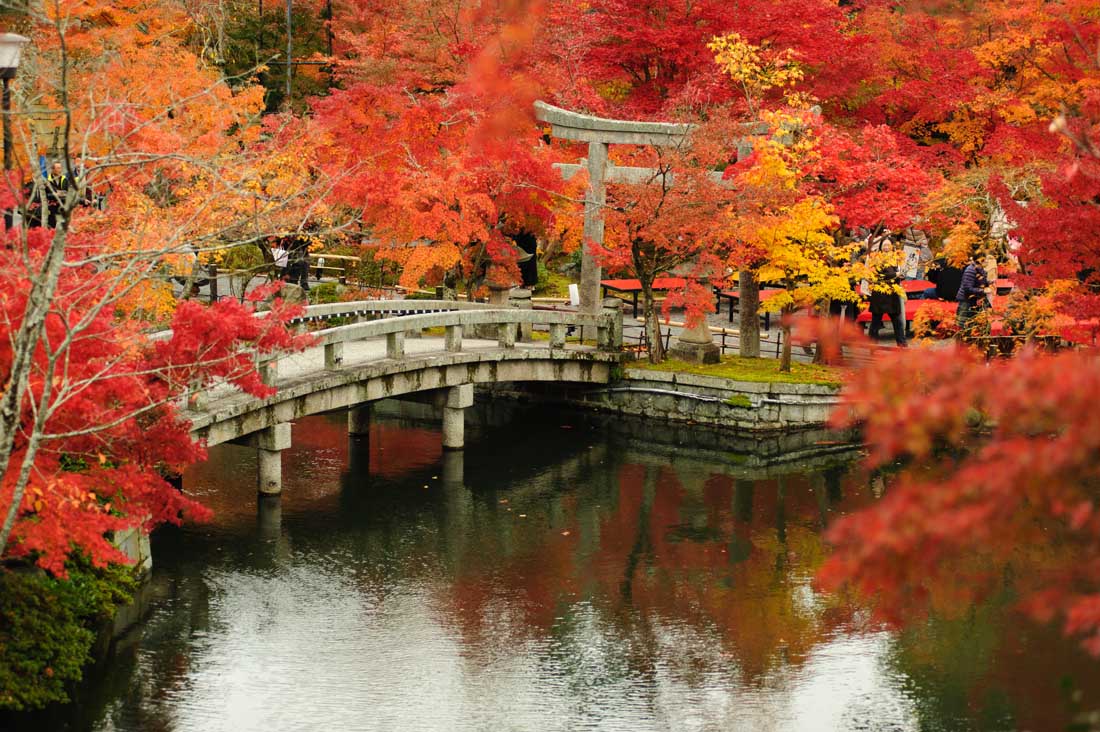Should I spend 1, 2, or 3 days in Kyoto?
Should you spend 1, 2, or 3 days in Kyoto?
Not sure how much time you'll need in Kyoto, Japan? Most people spend two to three days in Kyoto during their visit. After all, the historic city will let you tour the famous sights and museums, learn about the history of the town, admire the wonderful scenery, and taste delicious cuisine.
Kyoto was once the capital of Japan, and today it is a beautiful historic city that is filled with temples and traditional neighborhoods. There are gardens and palaces as well as traditional shops and dining opportunities. The city is filled with culture and fascinating places to wander and explore.
Do you have one or two days to visit Kyoto? Here's our comprehensive breakdown of how much time you might need for your trip along with some suggestions for things to do.
Is one day enough time in Kyoto?
One day is usually not enough time to experience the historic city of Kyoto, so you may find yourself somewhat rushed. You don't want to miss the chance to tour the famous sights and museums, learn about the history of the town, admire the wonderful scenery, and taste delicious cuisine. So, you'll likely want more than one day, as many tourists set aside around two to three days for their visit. However, if your schedule is tight, we have a handful of recommendations to make the most of your journey.
How to spend a day in Kyoto
Kyoto is home to renowned museums and iconic landmarks, so dive into the city's famous attractions. The city's historical sites rank among the most awe-inspiring globally. With its long-running history, there are many traditional buildings and temples in town. Nijo Castle is stunning to explore, but also make sure you visit the Fushimi-Inari Taisha Shrine, the Golden Pavilion, and Kiyomizu-dera Temple.
Kyoto Imperial Palace is worth visiting for around 2 hours, which is great for backpackers. Known for its beautifully preserved traditional Japanese architecture, expansive gardens, and rich history as the former residence of the Imperial family before the capital moved to Tokyo, entry is free.
Nijo Castle is worth visiting for around 2 hours, which is great for backpackers. Known for its beautifully preserved Edo-period architecture, stunning gardens, and the famous "nightingale floors" that chirp to alert against intruders, entry is ¥800.
You'll want to have around 1 hour for Kinkaku-ji (Golden Pavilion). It's a nice activity for couples and is known for its stunning gold-leaf-covered exterior that reflects beautifully in the surrounding pond, exemplifying traditional Japanese architecture and serene Zen garden design. It's ¥500 per adult to enter Kinkaku-ji (Golden Pavilion), with reduced prices for children and students; prices may be subject to change depending on season or exhibition..
Fushimi Inari Taisha is worth visiting for around 2 hours, which is great for families. Known for its thousands of vibrant red torii gates that form scenic trails up the sacred Mount Inari, dedicated to the Shinto god of rice and prosperity, entry is free.
It's worth around 2 hours for Kiyomizu-dera. Entry is it costs ¥400 for adults to enter (with discounts for children and students), and special exhibitions may have separate fees.. It's known for its stunning wooden stage that juts out from the main hall, offering panoramic views of the cherry and maple trees below, especially breathtaking during spring and autumn, as well as its historic significance as a UNESCO World Heritage site dating back to the 8th century.
Make sure to set aside around 1 hour for Sanjusangendo Hall, which is ¥600. It's great for backpackers and is known for its remarkable display of 1,001 life-sized statues of Kannon, the Buddhist goddess of mercy, arranged in a breathtaking wooden hall that stretches over 120 meters, making it one of the longest wooden structures in Japan.
Make sure to set aside around 1 hour for Ryoan-ji Temple, which is ¥500. It's great for backpackers and is known for its iconic rock garden, which features a minimalist arrangement of fifteen carefully placed stones amidst raked white gravel, designed to inspire meditation and contemplation.
It's worth around 1 hour for Heian Shrine. Entry is ¥600 to enter the Heian Shrine's beautiful gardens, while access to the main shrine grounds is free; children and group discounts may apply.. It's known for its striking torii gate, expansive gardens, and vibrant traditional festivals, including the annual Jidai Matsuri, which celebrates Kyoto's rich imperial history.
You'll want to have around 1 hour for To-ji Temple. It's a nice activity for backpackers and is known for its iconic five-story pagoda, the tallest wooden tower in Japan, as well as its monthly flea markets and historic association as a Shingon Buddhist temple founded in the early Heian period. It's ¥500.

A few tour suggestions include:
- Pedal Adventure Kyoto's iconic landmarks on an e-bike tour ($89)
- Nijo Castle and Imperial Palace Visit with Guide ($82)
- KIYOTO’s Signature Kyoto Experience: Landmarks & Hidden Gems ($89)
Kyoto is known to be such a beautiful destination, so just exploring and taking it all in should be one of the top things to do on your list. It's one of the most historical cities in Japan and it has many beautiful Buddhist temples, gardens, and imperial palaces. It's particularly striking during the cherry blossom season.

A few tour suggestions include:
- Kyoto Zen Meditation & Garden Tour at a Zen Temple with Lunch ($98)
- Kyoto Gion: 2-Hour Geisha Culture & History Walking Tour ($30)
- Kyoto Fushimi-Inari Night Walking Tour ($44)
Kyoto is a very walkable city. With only a day in the city, you'll have no trouble exploring the local sights. It's one of the most walkable cities in Japan and there are many sidewalks and pedestrian-friendly areas.
Is a weekend (two to three days) enough time in Kyoto?
As a popular city, Kyoto offers a large number of activities and attractions for visitors. So with a weekend, you'll probably feel rushed to see the main attractions. You really need more time to appreciate everything that the historic city has to offer. Many visitors prefer to have two to three days to fully enjoy the city. If you have a weekend or less, we still have some great ideas for what to do while you're in town.
 Eikando Temple, Kyoto, Japan
Eikando Temple, Kyoto, Japan
How to spend 2 days in Kyoto
Having a weekend (two to three days) in Kyoto will provide you with more time to take in the best activities in the city.
The charming atmosphere and history of the old town area is worth exploring, so spend the day learning about the history and culture of the area. This is among the most historic cities in Japan and there are many traditional buildings and temples. Higashiyama is filled with interesting districts and it has many UNESCO World Heritage temples.
You'll want to have around 2 hours for Nishiki Market. It's a nice activity for families and is known for its vibrant atmosphere and diverse array of fresh seafood, traditional Japanese sweets, local produce, and unique kitchenware, making it a must-visit destination for food lovers and cultural enthusiasts alike. It's free.

A few tour suggestions include:
- Kyoto Gion: 2-Hour Geisha Culture & History Walking Tour ($30)
- Kyoto Fushimi-Inari Night Walking Tour ($44)
- The Art of Geisha: Exclusive Show & Gion Walking Tour ($129)
You'll absolutely want to spend some time enjoying the food scene in this city, so make sure you spend time at one of the local restaurants where you can taste the delicious cuisine for a meal or two. The local cuisine is as beautiful as it is delicious. There is a long running history to many of the dishes, and the recipes are expertly prepared by world class chefs at many of the restaurants. You can enjoy everything from a tea ceremony to multi-course meals, referred to as kyo kaiseki.

A few tour suggestions include:
- Kyoto: Gion Local Food Tour (Taste 15 Dishes) ($90)
- Kyoto Ramen and Gyoza Cooking Class with Professional Chefs ($89)
- Ramen Cooking Class at Ramen Factory in Kyoto ($136)
Public transit in Kyoto is easy and efficient. In just a few days, you should be able to get around the city quite easily. The city has an extensive system of trains, subways, and buses that make it easy to get around.
More Info
If you're looking for more information about Kyoto, we have even more advice to help you plan your journey.
 Budget Your Trip is all about finding out how much everything costs so that you can travel cheaper and longer. Created by avid travelers Laurie and Bryan, our goal is to help you plan your next trip on the right budget. With average daily travel costs that are calculated from the budgets of real travelers, plus an analysis of hotel and tour prices, you can find out how much money you need to plan your next adventure. We also have plenty of travel advice, accommodation reviews, and activity suggestions.
Budget Your Trip is all about finding out how much everything costs so that you can travel cheaper and longer. Created by avid travelers Laurie and Bryan, our goal is to help you plan your next trip on the right budget. With average daily travel costs that are calculated from the budgets of real travelers, plus an analysis of hotel and tour prices, you can find out how much money you need to plan your next adventure. We also have plenty of travel advice, accommodation reviews, and activity suggestions.
Some of the links on this website are sponsored or affiliate links which help to financially support this site. By clicking the link and making a purchase, we may receive a small commission, but this does not affect the price of your purchase.
